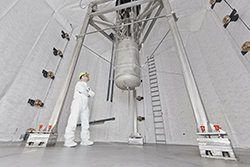World’s Most Sensitive Dark Matter Detector
 |
| www.sanfordlab.org click image for more information |
After its first run of more than three months, operating a mile underground in the Black Hills of South Dakota, a new experiment named LUX has proven itself the most sensitive dark matter detector in the world.
“This result shows that LUX is working quite well”, says Carter Hall, associate professor of physics at the University of Maryland and leader of the Maryland LUX group. “With just a fraction of our final dataset in hand, we’ve produced an important science result, and we’ve demonstrated the promise of the full dataset which we’ll be collecting in the coming years.”
LUX stands for Large Underground Xenon experiment. The scientific collaboration, which is supported by the National Science Foundation and DOE, includes 17 research universities and national laboratories in the United States, the United Kingdom, and Portugal. Researchers from the University of Maryland, including Prof. Hall and graduate students Attila Dobi, Richard Knoche and Jon Balajthy, have played a prominent role in the design, construction, and operation of the detector as well as the recent analysis of the dark matter search data.
Dark matter, so far observed only by its gravitational effects on galaxies and clusters of galaxies, is the predominant form of matter in the universe. Weakly interacting massive particles, or WIMPs – so-called because they rarely interact with ordinary matter except through gravity – are the leading theoretical candidates for dark matter. Theories and results from other experiments suggest that WIMPs could be either “high mass” or “low mass.”
Assuming a high-mass WIMP with a mass of 35 GeV/c2 , LUX has a sensitivity that is more than two times better than any other experiment to directly detect dark matter. (Physicists express the mass of subatomic particles in electron volts (eV) divided by the speed of light squared (c2 ) A giga-electron volt (GeV) is a billion electron volts). LUX also has greatly enhanced sensitivity to low-mass WIMPs, whose possible detection has been suggested by other experiments. Three candidate WIMP events recently reported in ultra-cold silicon detectors, however, would have produced more than 1,600 events in LUX’s much larger detector, or one every 80 minutes in the recent run. No such signals were seen.
“This is only the beginning for LUX,” Dan McKinsey of Yale University says. “Now that we understand the instrument and its backgrounds, we will continue to take data, testing for more and more elusive candidates for dark matter.”
In both theory and practice, collisions between WIMPs and normal matter are rare and extremely difficult to detect, especially because a constant rain of cosmic radiation from space can drown out the faint signals. That’s why LUX is searching for WIMPs 4,850 feet underground in the Sanford Lab, where few cosmic ray particles can penetrate. The detector is further protected from background radiation from the surrounding rock by immersion in a tank of ultra-pure water.
At the heart of the experiment is a 6-foot-tall titanium tank filled with almost a third of a ton of liquid xenon, cooled to minus 150 degrees Fahrenheit. If a WIMP strikes a xenon atom it recoils from other xenon atoms and emits photons (light) and electrons. The electrons are drawn upward by an electrical field and interact with a thin layer of xenon gas at the top of the tank, releasing more photons.
Light detectors in the top and bottom of the tank are each capable of detecting a single photon, so the locations of the two photon signals – one at the collision point, the other at the top of the tank – can be pinpointed to within a few millimeters. The energy of the interaction can be precisely measured from the brightness of the signals.
“LUX is a complex instrument,” says McKinsey, “but it insures that each WIMP event’s unique signature of position and energy will be precisely recorded.”
LUX’s biggest advantage as a dark matter detector is its size, a large xenon target whose outer regions further shield the interior from gamma rays and neutrons. Installed in the Sanford Lab in the summer of 2012, the experiment was filled with liquid xenon in February, and its first run of three months was conducted this spring and summer, followed by intensive analysis of the data. The dark matter search will continue through the next two years.
"The universe's mysterious dark sector presents us with two of the most thrilling challenges in all of physics," says Saul Perlmutter of DOE’s Lawrence Berkeley National Laboratory (Berkeley Lab), a winner of the 2011 Nobel Prize in Physics for discovering the accelerating expansion of the universe. "We call it the dark sector precisely because we don't know what accounts for most of the energy and mass in the universe. Dark energy is one challenge, and as for the other, the LUX experiment's first data now take the lead in the hunt for the dark matter component of the dark sector."
South Dakota Gov. Dennis Daugaard says his state is proud to play a role in this important research. Homestake Mining Co. donated its gold mine in Lead to the South Dakota Science and Technology Authority, which reopened it in 2007 with funding from the state Legislature and a $70 million donation from philanthropist T. Denny Sanford. “We congratulate the LUX researchers, and we look forward to working with dark matter scientists and other partners in the years to come,” Daugaard says.
The LUX announcement is major step forward for the Sanford Lab’s science program, which Laboratory Director Mike Headley points out has its roots in a famous physics experiment installed in the same experiment hall in the 1960s. “These are the first physics results achieved at Homestake since the Ray Davis solar neutrino experiment, which earned him a Nobel Prize for Physics,” Headley says. “I’m very proud of our staff’s work to help LUX reach this major milestone.”